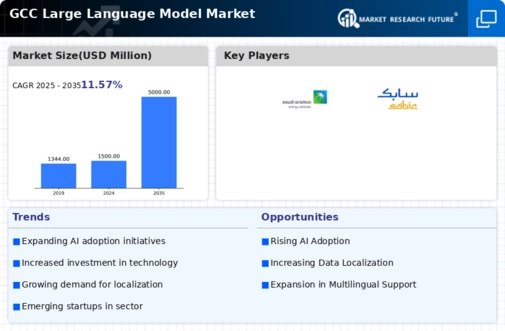The large language-model market is currently characterized by intense competition and rapid innovation, driven by advancements in artificial intelligence (AI) and increasing demand for natural language processing (NLP) solutions. Key players such as OpenAI (US), Google (US), and Microsoft (US) are at the forefront, each adopting distinct strategies to enhance their market positioning. OpenAI (US) focuses on developing cutting-edge models that prioritize ethical AI use, while Google (US) leverages its extensive data resources to refine its language models. Microsoft (US) emphasizes strategic partnerships, particularly with OpenAI, to integrate advanced language capabilities into its suite of products, thereby enhancing user experience and operational efficiency. Collectively, these strategies contribute to a competitive landscape that is both dynamic and multifaceted, with each player striving to carve out a unique niche in the market.
In terms of business tactics, companies are increasingly localizing their operations to better serve regional markets, optimizing supply chains to enhance efficiency, and investing in research and development to drive innovation. The competitive structure of the market appears moderately fragmented, with several key players exerting substantial influence. This fragmentation allows for a diverse range of offerings, catering to various customer needs and preferences, while also fostering an environment ripe for collaboration and competition.
In October 2025, OpenAI (US) announced a partnership with several educational institutions to develop tailored language models aimed at enhancing learning outcomes. This initiative underscores OpenAI's commitment to applying its technology in socially beneficial ways, potentially expanding its user base and reinforcing its reputation as a leader in ethical AI development. Such collaborations may also facilitate the integration of AI into educational frameworks, thereby driving further adoption of language models in academic settings.
In September 2025, Google (US) unveiled a new suite of tools designed to enhance multilingual capabilities in its language models. This strategic move is indicative of Google's intent to capture a broader audience, particularly in regions with diverse linguistic needs. By enhancing its models' ability to understand and generate text in multiple languages, Google positions itself as a more inclusive player in the market, likely increasing its competitive edge against rivals.
In August 2025, Microsoft (US) expanded its Azure AI services to include advanced language processing features, aimed at enterprise clients. This expansion reflects Microsoft's strategy to integrate AI capabilities into its cloud offerings, thereby enhancing the value proposition for businesses seeking to leverage language models for operational efficiency. By doing so, Microsoft not only strengthens its market position but also aligns with the growing trend of digital transformation across industries.
As of November 2025, the competitive trends shaping the landscape include a pronounced focus on digitalization, sustainability, and the integration of AI across various sectors. Strategic alliances are increasingly pivotal, as companies recognize the value of collaboration in driving innovation and expanding market reach. Looking ahead, competitive differentiation is likely to evolve, with a shift from price-based competition towards innovation, technological advancement, and supply chain reliability. This transition suggests that companies will need to prioritize not only the development of superior products but also the establishment of robust partnerships to navigate the complexities of the market.

















Leave a Comment